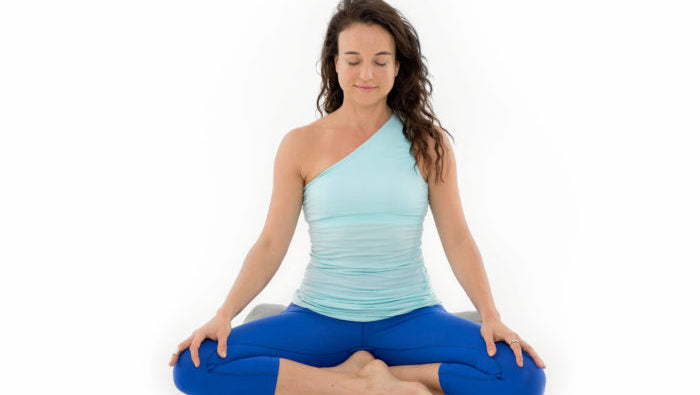 2) Foot bath:
A simple foot bath is a great way to calm the nervous system and relax the mind to help you unwind in preparation for deep sleep. For this one as well, get yourself ready for bed and dim the lights so that you can go directly to bed afterwards,. Find a place in your house where you can soak your feet in warm water (as warm as you can tolerate and still relax). I prefer a sink, if you can sit on the counter easily, as you can refill the water warmer and warmer as your feet adapt. A bathtub can work as well, but it requires more water. You can also improvise with a bucket, but it’s more difficult to refill if you want warmer water. You can add a few drops of lavender oil to help you relax if you like, but it’s not necessary. Stay for 5-10 minutes or until your feet are warm all the way through. Then dry your feet and head straight to bed (put on some socks if you have a long way to walk so your feet are still warm when you get to bed). This one is especially helpful if you tend to have trouble sleeping and your mind won’t turn off at night.
3) Essential Oils:
Essential oils can be a great way to help you transition into sleep mode as well. You can place a few drops on your pillow each night or use a diffuser in your bedroom. This simple trick can be a great way to create a more relaxed tone in your bedroom as you slow down. I always recommend turning off all electronics at least 1-2 hours before bed, as they can be disruptive to your body’s preparation for deep sleep. My favorite oils are lavender, chamomile, sandalwood and bergamot – pick the one that you like best. This method is nice if you travel a lot, as you can carry a small bottle with you and use it on your pillow in the hotel.
4) Meditation
I can’t say enough how helpful meditation is for sleep, but it’s not usually an instant solution so I have put this one last. In my experience, though, having a regular meditation practice helps more in the long term. It doesn’t need to be a specific type or length of meditation – if you have a favorite, proceed with that – but it does need to be done on a daily basis for the full effect. You can do it in the morning or the evening, as this is meant as a long-term training tool for the nervous system rather than an immediate sleep fix, but meditation can be more helpful for sleep when done anytime in the evening as you unwind from your day. If you aren’t familiar with meditation, a simple way to do this is to find a comfortable sitting position in a chair or on the floor, close your eyes, and then begin to notice all of the sensations and movements of your breath. Start by counting each exhale until you get to 10 and then starting over. This is a simple technique to bring the awareness to one point of focus (the opposite of the multitasking we do on a daily basis) in order to allow the nervous system to settle into relaxation mode. If you lose your place or end up at 20, it doesn't really matter; just begin again at 1 and try to stay present with it. Try not to control or regulate the breath, though – simply count your natural breath. I recommend setting a timer on your phone for 5-10 minutes so you don’t have to think about time. Commit to a time and place you can meditate daily, and allow yourself those 5-10 minutes every day as your time to allow your nervous system to reset from or ahead of your busy day.
Want more? You might also like:
Yoga Expert Tiffany Cruikshank On How You Can Meditate to Lose Weight and Control Cravings
11 Root Causes of Why You’re Always Tired… and How to Fix It!
Success Story: A Raw Food Diet Helped My Client Lose Weight, Sleep Better, and Reduce Anxiety
For more yoga inspired tips, read Tiffany’s book on Optimal Health for a Vibrant Life: A 30-Day Program to Detoxify and Replenish Body and Mind.
2) Foot bath:
A simple foot bath is a great way to calm the nervous system and relax the mind to help you unwind in preparation for deep sleep. For this one as well, get yourself ready for bed and dim the lights so that you can go directly to bed afterwards,. Find a place in your house where you can soak your feet in warm water (as warm as you can tolerate and still relax). I prefer a sink, if you can sit on the counter easily, as you can refill the water warmer and warmer as your feet adapt. A bathtub can work as well, but it requires more water. You can also improvise with a bucket, but it’s more difficult to refill if you want warmer water. You can add a few drops of lavender oil to help you relax if you like, but it’s not necessary. Stay for 5-10 minutes or until your feet are warm all the way through. Then dry your feet and head straight to bed (put on some socks if you have a long way to walk so your feet are still warm when you get to bed). This one is especially helpful if you tend to have trouble sleeping and your mind won’t turn off at night.
3) Essential Oils:
Essential oils can be a great way to help you transition into sleep mode as well. You can place a few drops on your pillow each night or use a diffuser in your bedroom. This simple trick can be a great way to create a more relaxed tone in your bedroom as you slow down. I always recommend turning off all electronics at least 1-2 hours before bed, as they can be disruptive to your body’s preparation for deep sleep. My favorite oils are lavender, chamomile, sandalwood and bergamot – pick the one that you like best. This method is nice if you travel a lot, as you can carry a small bottle with you and use it on your pillow in the hotel.
4) Meditation
I can’t say enough how helpful meditation is for sleep, but it’s not usually an instant solution so I have put this one last. In my experience, though, having a regular meditation practice helps more in the long term. It doesn’t need to be a specific type or length of meditation – if you have a favorite, proceed with that – but it does need to be done on a daily basis for the full effect. You can do it in the morning or the evening, as this is meant as a long-term training tool for the nervous system rather than an immediate sleep fix, but meditation can be more helpful for sleep when done anytime in the evening as you unwind from your day. If you aren’t familiar with meditation, a simple way to do this is to find a comfortable sitting position in a chair or on the floor, close your eyes, and then begin to notice all of the sensations and movements of your breath. Start by counting each exhale until you get to 10 and then starting over. This is a simple technique to bring the awareness to one point of focus (the opposite of the multitasking we do on a daily basis) in order to allow the nervous system to settle into relaxation mode. If you lose your place or end up at 20, it doesn't really matter; just begin again at 1 and try to stay present with it. Try not to control or regulate the breath, though – simply count your natural breath. I recommend setting a timer on your phone for 5-10 minutes so you don’t have to think about time. Commit to a time and place you can meditate daily, and allow yourself those 5-10 minutes every day as your time to allow your nervous system to reset from or ahead of your busy day.
Want more? You might also like:
Yoga Expert Tiffany Cruikshank On How You Can Meditate to Lose Weight and Control Cravings
11 Root Causes of Why You’re Always Tired… and How to Fix It!
Success Story: A Raw Food Diet Helped My Client Lose Weight, Sleep Better, and Reduce Anxiety
For more yoga inspired tips, read Tiffany’s book on Optimal Health for a Vibrant Life: A 30-Day Program to Detoxify and Replenish Body and Mind.
Simple Yoga Techniques to Help you Reset Your Mind and Body for a Better Night’s Sleep

Sleep has become a problem of epidemic proportions in our modern day lives. It seems we are always looking for ways to get better sleep. But erratic, jam-packed schedules, diet patterns, and psychological obstacles can make those zzzs ever so elusive. So are there any simple tips and tricks to getting that quality shut eye we cherish so dearly? Yoga-inspired techniques like meditation might be just what we need to achieve that relaxed state of mind.
Interestingly enough, the fact that we are now so aware of how important sleep is for our health and wellbeing only makes sleeping more difficult. Attempting to fall asleep-- and failing-- only heightens the anxiety, making the actual art of falling asleep that much more difficult to master. More often than not, this can become a vicious cycle. The two biggest issues for sleep are 1. Falling asleep and 2. Staying asleep. The reasons are endless.
There are numerous factors that can both positively and adversely affect sleep, but the one thing that I have seen over and over is the inability of the nervous system to transition from a state of “awake and alert” (and thinking/planning) to one of relaxation and sleep. The key, then, is to help ease this transition more fluidly.
The suggestions below are all tips and strategies that I have found to be helpful with my patients and yoga students who are trying to improve their sleep quality. Try one or do several, but focus on keeping things simple for yourself. Though many of these suggestions may help your sleep the first night, they will be more useful long-term if you can pick one or two that you can truly commit to every evening to create a personalized sleep ritual. The nervous system actually needs that routine to help redefine and refine your sleep patterns. So take a peek below and customize a bedtime ritual that works for you. In no time, you’ll be drifting off into a deep and blissful sleep...
1) Pose: Legs up the wall pose
To begin, make sure you are ready for bed. To help ease yourself into this mindset, try to dim or turn off the lights in your bedroom, where you will be doing this pose. Begin sitting with your right side up against a wall, then support yourself so you can gently lie down on your back with your hips against the wall. Extend your legs up the wall as you allow your torso and head to lay back into the floor and relax. If your hamstrings are tight, feel free to move your hips away from the wall a bit until you are comfortable there, then close your eyes and try to relax your entire body. As you relax, notice your breath. Once you feel relaxed, start to count your inhale and exhale without any tension or gripping. Give yourself permission to linger a couple seconds longer on the exhalation. Continue at this pace for 3-5 minutes. Next, let the breath be natural for a few minutes before you slowly roll onto your side and carefully crawl right into bed.
 2) Foot bath:
A simple foot bath is a great way to calm the nervous system and relax the mind to help you unwind in preparation for deep sleep. For this one as well, get yourself ready for bed and dim the lights so that you can go directly to bed afterwards,. Find a place in your house where you can soak your feet in warm water (as warm as you can tolerate and still relax). I prefer a sink, if you can sit on the counter easily, as you can refill the water warmer and warmer as your feet adapt. A bathtub can work as well, but it requires more water. You can also improvise with a bucket, but it’s more difficult to refill if you want warmer water. You can add a few drops of lavender oil to help you relax if you like, but it’s not necessary. Stay for 5-10 minutes or until your feet are warm all the way through. Then dry your feet and head straight to bed (put on some socks if you have a long way to walk so your feet are still warm when you get to bed). This one is especially helpful if you tend to have trouble sleeping and your mind won’t turn off at night.
3) Essential Oils:
Essential oils can be a great way to help you transition into sleep mode as well. You can place a few drops on your pillow each night or use a diffuser in your bedroom. This simple trick can be a great way to create a more relaxed tone in your bedroom as you slow down. I always recommend turning off all electronics at least 1-2 hours before bed, as they can be disruptive to your body’s preparation for deep sleep. My favorite oils are lavender, chamomile, sandalwood and bergamot – pick the one that you like best. This method is nice if you travel a lot, as you can carry a small bottle with you and use it on your pillow in the hotel.
4) Meditation
I can’t say enough how helpful meditation is for sleep, but it’s not usually an instant solution so I have put this one last. In my experience, though, having a regular meditation practice helps more in the long term. It doesn’t need to be a specific type or length of meditation – if you have a favorite, proceed with that – but it does need to be done on a daily basis for the full effect. You can do it in the morning or the evening, as this is meant as a long-term training tool for the nervous system rather than an immediate sleep fix, but meditation can be more helpful for sleep when done anytime in the evening as you unwind from your day. If you aren’t familiar with meditation, a simple way to do this is to find a comfortable sitting position in a chair or on the floor, close your eyes, and then begin to notice all of the sensations and movements of your breath. Start by counting each exhale until you get to 10 and then starting over. This is a simple technique to bring the awareness to one point of focus (the opposite of the multitasking we do on a daily basis) in order to allow the nervous system to settle into relaxation mode. If you lose your place or end up at 20, it doesn't really matter; just begin again at 1 and try to stay present with it. Try not to control or regulate the breath, though – simply count your natural breath. I recommend setting a timer on your phone for 5-10 minutes so you don’t have to think about time. Commit to a time and place you can meditate daily, and allow yourself those 5-10 minutes every day as your time to allow your nervous system to reset from or ahead of your busy day.
Want more? You might also like:
Yoga Expert Tiffany Cruikshank On How You Can Meditate to Lose Weight and Control Cravings
11 Root Causes of Why You’re Always Tired… and How to Fix It!
Success Story: A Raw Food Diet Helped My Client Lose Weight, Sleep Better, and Reduce Anxiety
For more yoga inspired tips, read Tiffany’s book on Optimal Health for a Vibrant Life: A 30-Day Program to Detoxify and Replenish Body and Mind.
2) Foot bath:
A simple foot bath is a great way to calm the nervous system and relax the mind to help you unwind in preparation for deep sleep. For this one as well, get yourself ready for bed and dim the lights so that you can go directly to bed afterwards,. Find a place in your house where you can soak your feet in warm water (as warm as you can tolerate and still relax). I prefer a sink, if you can sit on the counter easily, as you can refill the water warmer and warmer as your feet adapt. A bathtub can work as well, but it requires more water. You can also improvise with a bucket, but it’s more difficult to refill if you want warmer water. You can add a few drops of lavender oil to help you relax if you like, but it’s not necessary. Stay for 5-10 minutes or until your feet are warm all the way through. Then dry your feet and head straight to bed (put on some socks if you have a long way to walk so your feet are still warm when you get to bed). This one is especially helpful if you tend to have trouble sleeping and your mind won’t turn off at night.
3) Essential Oils:
Essential oils can be a great way to help you transition into sleep mode as well. You can place a few drops on your pillow each night or use a diffuser in your bedroom. This simple trick can be a great way to create a more relaxed tone in your bedroom as you slow down. I always recommend turning off all electronics at least 1-2 hours before bed, as they can be disruptive to your body’s preparation for deep sleep. My favorite oils are lavender, chamomile, sandalwood and bergamot – pick the one that you like best. This method is nice if you travel a lot, as you can carry a small bottle with you and use it on your pillow in the hotel.
4) Meditation
I can’t say enough how helpful meditation is for sleep, but it’s not usually an instant solution so I have put this one last. In my experience, though, having a regular meditation practice helps more in the long term. It doesn’t need to be a specific type or length of meditation – if you have a favorite, proceed with that – but it does need to be done on a daily basis for the full effect. You can do it in the morning or the evening, as this is meant as a long-term training tool for the nervous system rather than an immediate sleep fix, but meditation can be more helpful for sleep when done anytime in the evening as you unwind from your day. If you aren’t familiar with meditation, a simple way to do this is to find a comfortable sitting position in a chair or on the floor, close your eyes, and then begin to notice all of the sensations and movements of your breath. Start by counting each exhale until you get to 10 and then starting over. This is a simple technique to bring the awareness to one point of focus (the opposite of the multitasking we do on a daily basis) in order to allow the nervous system to settle into relaxation mode. If you lose your place or end up at 20, it doesn't really matter; just begin again at 1 and try to stay present with it. Try not to control or regulate the breath, though – simply count your natural breath. I recommend setting a timer on your phone for 5-10 minutes so you don’t have to think about time. Commit to a time and place you can meditate daily, and allow yourself those 5-10 minutes every day as your time to allow your nervous system to reset from or ahead of your busy day.
Want more? You might also like:
Yoga Expert Tiffany Cruikshank On How You Can Meditate to Lose Weight and Control Cravings
11 Root Causes of Why You’re Always Tired… and How to Fix It!
Success Story: A Raw Food Diet Helped My Client Lose Weight, Sleep Better, and Reduce Anxiety
For more yoga inspired tips, read Tiffany’s book on Optimal Health for a Vibrant Life: A 30-Day Program to Detoxify and Replenish Body and Mind.
 2) Foot bath:
A simple foot bath is a great way to calm the nervous system and relax the mind to help you unwind in preparation for deep sleep. For this one as well, get yourself ready for bed and dim the lights so that you can go directly to bed afterwards,. Find a place in your house where you can soak your feet in warm water (as warm as you can tolerate and still relax). I prefer a sink, if you can sit on the counter easily, as you can refill the water warmer and warmer as your feet adapt. A bathtub can work as well, but it requires more water. You can also improvise with a bucket, but it’s more difficult to refill if you want warmer water. You can add a few drops of lavender oil to help you relax if you like, but it’s not necessary. Stay for 5-10 minutes or until your feet are warm all the way through. Then dry your feet and head straight to bed (put on some socks if you have a long way to walk so your feet are still warm when you get to bed). This one is especially helpful if you tend to have trouble sleeping and your mind won’t turn off at night.
3) Essential Oils:
Essential oils can be a great way to help you transition into sleep mode as well. You can place a few drops on your pillow each night or use a diffuser in your bedroom. This simple trick can be a great way to create a more relaxed tone in your bedroom as you slow down. I always recommend turning off all electronics at least 1-2 hours before bed, as they can be disruptive to your body’s preparation for deep sleep. My favorite oils are lavender, chamomile, sandalwood and bergamot – pick the one that you like best. This method is nice if you travel a lot, as you can carry a small bottle with you and use it on your pillow in the hotel.
4) Meditation
I can’t say enough how helpful meditation is for sleep, but it’s not usually an instant solution so I have put this one last. In my experience, though, having a regular meditation practice helps more in the long term. It doesn’t need to be a specific type or length of meditation – if you have a favorite, proceed with that – but it does need to be done on a daily basis for the full effect. You can do it in the morning or the evening, as this is meant as a long-term training tool for the nervous system rather than an immediate sleep fix, but meditation can be more helpful for sleep when done anytime in the evening as you unwind from your day. If you aren’t familiar with meditation, a simple way to do this is to find a comfortable sitting position in a chair or on the floor, close your eyes, and then begin to notice all of the sensations and movements of your breath. Start by counting each exhale until you get to 10 and then starting over. This is a simple technique to bring the awareness to one point of focus (the opposite of the multitasking we do on a daily basis) in order to allow the nervous system to settle into relaxation mode. If you lose your place or end up at 20, it doesn't really matter; just begin again at 1 and try to stay present with it. Try not to control or regulate the breath, though – simply count your natural breath. I recommend setting a timer on your phone for 5-10 minutes so you don’t have to think about time. Commit to a time and place you can meditate daily, and allow yourself those 5-10 minutes every day as your time to allow your nervous system to reset from or ahead of your busy day.
Want more? You might also like:
Yoga Expert Tiffany Cruikshank On How You Can Meditate to Lose Weight and Control Cravings
11 Root Causes of Why You’re Always Tired… and How to Fix It!
Success Story: A Raw Food Diet Helped My Client Lose Weight, Sleep Better, and Reduce Anxiety
For more yoga inspired tips, read Tiffany’s book on Optimal Health for a Vibrant Life: A 30-Day Program to Detoxify and Replenish Body and Mind.
2) Foot bath:
A simple foot bath is a great way to calm the nervous system and relax the mind to help you unwind in preparation for deep sleep. For this one as well, get yourself ready for bed and dim the lights so that you can go directly to bed afterwards,. Find a place in your house where you can soak your feet in warm water (as warm as you can tolerate and still relax). I prefer a sink, if you can sit on the counter easily, as you can refill the water warmer and warmer as your feet adapt. A bathtub can work as well, but it requires more water. You can also improvise with a bucket, but it’s more difficult to refill if you want warmer water. You can add a few drops of lavender oil to help you relax if you like, but it’s not necessary. Stay for 5-10 minutes or until your feet are warm all the way through. Then dry your feet and head straight to bed (put on some socks if you have a long way to walk so your feet are still warm when you get to bed). This one is especially helpful if you tend to have trouble sleeping and your mind won’t turn off at night.
3) Essential Oils:
Essential oils can be a great way to help you transition into sleep mode as well. You can place a few drops on your pillow each night or use a diffuser in your bedroom. This simple trick can be a great way to create a more relaxed tone in your bedroom as you slow down. I always recommend turning off all electronics at least 1-2 hours before bed, as they can be disruptive to your body’s preparation for deep sleep. My favorite oils are lavender, chamomile, sandalwood and bergamot – pick the one that you like best. This method is nice if you travel a lot, as you can carry a small bottle with you and use it on your pillow in the hotel.
4) Meditation
I can’t say enough how helpful meditation is for sleep, but it’s not usually an instant solution so I have put this one last. In my experience, though, having a regular meditation practice helps more in the long term. It doesn’t need to be a specific type or length of meditation – if you have a favorite, proceed with that – but it does need to be done on a daily basis for the full effect. You can do it in the morning or the evening, as this is meant as a long-term training tool for the nervous system rather than an immediate sleep fix, but meditation can be more helpful for sleep when done anytime in the evening as you unwind from your day. If you aren’t familiar with meditation, a simple way to do this is to find a comfortable sitting position in a chair or on the floor, close your eyes, and then begin to notice all of the sensations and movements of your breath. Start by counting each exhale until you get to 10 and then starting over. This is a simple technique to bring the awareness to one point of focus (the opposite of the multitasking we do on a daily basis) in order to allow the nervous system to settle into relaxation mode. If you lose your place or end up at 20, it doesn't really matter; just begin again at 1 and try to stay present with it. Try not to control or regulate the breath, though – simply count your natural breath. I recommend setting a timer on your phone for 5-10 minutes so you don’t have to think about time. Commit to a time and place you can meditate daily, and allow yourself those 5-10 minutes every day as your time to allow your nervous system to reset from or ahead of your busy day.
Want more? You might also like:
Yoga Expert Tiffany Cruikshank On How You Can Meditate to Lose Weight and Control Cravings
11 Root Causes of Why You’re Always Tired… and How to Fix It!
Success Story: A Raw Food Diet Helped My Client Lose Weight, Sleep Better, and Reduce Anxiety
For more yoga inspired tips, read Tiffany’s book on Optimal Health for a Vibrant Life: A 30-Day Program to Detoxify and Replenish Body and Mind.





















